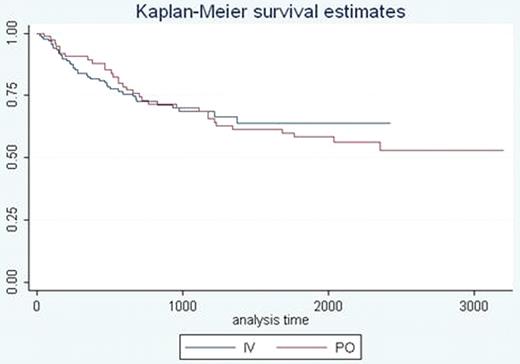Abstract
Abstract 1359
Improved survival has been observed after replacing oral with intravenous (iv) busulfan in autologous stem cell transplantation (ASCT) for lymphoma conditioned with busulfan (Bu), cyclophosphamide (Cy) and etoposide (VP-16; Dean et al., Br J Hematol. 2010), but it is unknown whether PK-directed iv Bu dosing is associated with additional improvements in safety or efficacy. To address this issue we performed an IRB-approved retrospective cohort study to compare the efficacy of PK-directed oral and iv Bu in lymphoma patients undergoing ASCT from 2000–2010 at Emory University.
Patients included for analysis received oral Bu (1.0mg/kg every 6 hours × 16, n=97), or iv Bu (0.9mg/kg every 6 hours × 16, n=199) followed by Cy (60mg/kg qd × 2), etoposide (10 mg/kg qd x3) and infusion of previous collected autologous stem cells. Baseline demographic, lymphoma subtype, disease status, body weight (kg), body surface area (BSA), body mass index (BMI; kg/m2), stem cell dose, and other clinical and ASCT parameters were compared for oral and iv groups. Bu area under the curve (AUC), maximum bilirubin, and overall survival (OS) were compared for oral and iv groups using Chi-squared statistics and Cox regression models.
Diagnosis was comparable across two treatment groups except the oral treatment group had slightly higher number of NHL (58%) than iv group (43%, p=0.04). The median age and percentage of males were 43 (range 19–66) and 45 (17-69), 67% and 62.3% for oral and iv groups, respectively. Patients who received oral and iv Bu did not differ by race, mean weight, BMI, stem cell dose and disease status. BSA was greater in the iv busulfan group (p=0.03). Pharmacokinetic-directed dosing was performed in both treatment groups with a total target AUC of 20,000μMol-min. Following the initial Bu dose, the Bu half-life (mean ± std., oral: 225.8 ± 104.4, iv: 189.4 ± 47.5; p=0.0026) and total targeted AUC (oral: 20,534 ± 2,969, iv: 19,695 ± 1,434; p=0.01) were significantly different between two treatment groups. 44% of patients in oral group (n=94) and 88% of patients in the iv group (n=178) achieved targeted AUC between 18,000-22,000μMol-min. PK-directed Bu dosing generated a narrower AUC range in the iv treatment groups compared with that in the oral groups (Figure 1). Regimen-related toxicities, including VOD, were similar between patients in the oral and iv groups, with 100-day mortality of 3% and 4%, respectively (p=NS). With a mean follow-up of 1,521 and 789 days for oral and iv Bu groups, 58% and 72% patients were alive in each group respectively (Figure 2). In multivariate Cox regression models, age (HR=1.03, CL 1.01–1.05, p=0.001) significantly influenced survival, but route of Bu administration did not. Oral and iv PK-directed Bu had 2-year OS of 77% and 92% in this cohort.
PK-directed iv Bu improves the consistency of delivering target AUC over oral PK-directed Bu with similar survival outcomes for lymphoma patients undergoing ASCT. The narrow CI for final AUC among patients receiving PK-directed iv Bu may safely permit dose-escalation of busulfan administered as part of high-dose conditioning to improve transplant efficacy.
Flowers:Genentech/Biogen-Idec (unpaid): Consultancy; Celgene, Intellikine: Consultancy; Millennium: Research Funding; Otsuka: Research Funding. Waller:Otsuka: Research Funding.
Author notes
Asterisk with author names denotes non-ASH members.



This feature is available to Subscribers Only
Sign In or Create an Account Close Modal